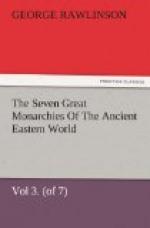Finally, towards the east lay the great salt desert, sparsely inhabited by various nomadic races, among which the most important were the Cossseans and the Sagartians. To the latter people Herodotus seems to assign almost the whole of the sandy region, since he unites them with the Sarangians and Thamanseans on the one hand, with the Utians and Mycians upon the other. They were a wild race, probably of Arian origin, who hunted with the lasso over the great desert mounted on horses, and could bring into the field a force of eight or ten thousand men. Their country, a waste of sand and gravel, in parts thickly encrusted with salt, was impassable to an army, and formed a barrier which effectively protected Media along the greater portion of her eastern frontier. Towards the extreme north-east the Sagartians were replaced by the Cossseans and the Parthians, the former probably the people of the Siah-Koh mountain, the latter the inhabitants of the tract known now as the Atak, or “skirt,” which extends along the southern flank of the Elburz range from the Caspian Gates nearly to Herat, and is capable of sustaining a very considerable population. The Cossseans were plunderers, from whose raids Media suffered constant annoyance; but they were at no time of sufficient strength to cause any serious fear. The Parthians, as we learn from the course of events, had in them the materials of a mighty people; but the hour for their elevation and expansion was not yet come, and the keenest observer of Median times could scarcely have perceived in them the future lords of Western Asia. From Parthia, moreover, Media was divided by the strong rocky spur which runs out from the Elburz into the desert in long. 52 deg. 10’ nearly, over which is the narrow pass already mentioned as the Caspian Gates. Thus Media on most sides was guarded by the strong natural barriers of seas, mountains, and deserts lying open only on the south, where she adjoined upon a kindred people. Her neighbors were for the most part weak in numbers, though warlike. Armenia, however, to the north-west, Assyria to the west, and Persia to the south, were all more or less formidable. A prescient eye might have foreseen that the great struggles of Media would be with these powers, and that if she attained imperial proportions it must be by their subjugation or absorption.
CHAPTER II. CLIMATE AND PRODUCTIONS.
Media, like Assyria, is a country of such extent and variety that, in order to give a correct description of its climate, we must divide it into regions. Azerbijan, or Atropatene, the most northern portion, has a climate altogether cooler than the rest of Media; while in the more southern division of the country there is a marked difference between the climate of the east and of the west, of the tracts lying on the high plateau and skirting the Great Salt Desert, and of those contained within or closely abutting upon




